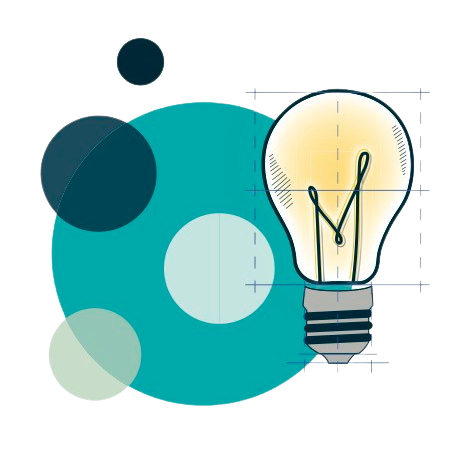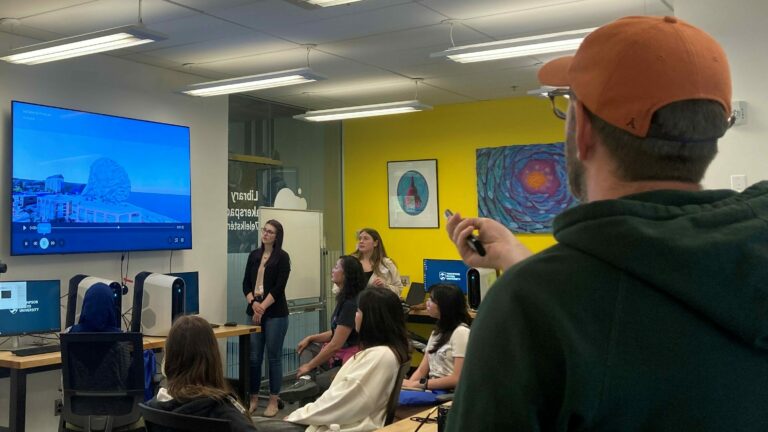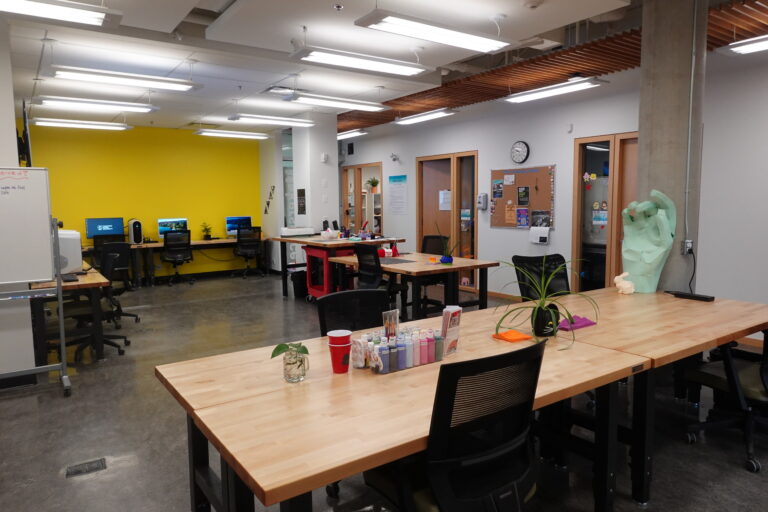TRU Library Makerspace Librarian’s Report – 2024-2025 Academic Year
Submitted by: Franklin Sayre, Makerspace Librarian
Date: May 12, 2025
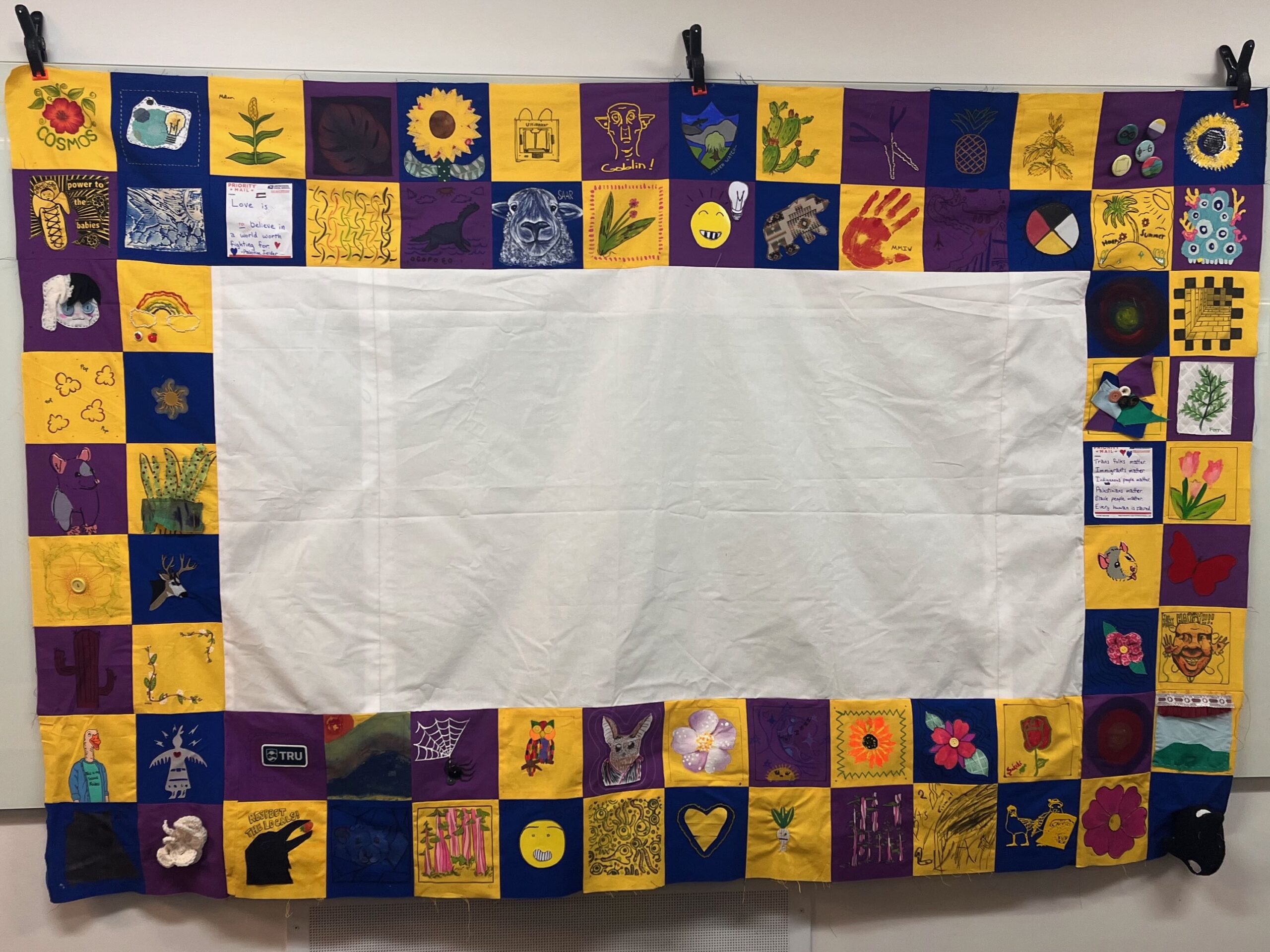
Welcome to the 2024-2025 TRU Makerspace Librarian’s Report! This March we marked three years since we opened the space. Every day, I’m inspired by the remarkable creativity, boundless energy, and genuine kindness our students, staff, and faculty partners bring to this space. This report represents a shift from term-based to annual reporting. Since this is the first report using this schedule, it covers the period from September 2024 to the end of April 2025. A summer 2024 report is available on our website along with all previous reports https://makerspace.trubox.ca/tag/reports/
For those short on time, the highlights section and opening statistics will give you the essential takeaways: this year we’ve seen increased use, more ambitious projects, wider curriculum integration, and stronger campus partnerships than ever before. For those interested in our previous activities, our Summer 2024 report and earlier updates remain available on our website.
Highlights
Community Art Banner
This year we were one of four campus groups that worked with students in the Visual Arts and Communications “VISA 3210: Making Art with Community” class led by Professor Twyla Exner. Students Chantel Manuel, Bryanna Dyer, Kaitlyn Bartlett, and Fausto Richard-Guerrero worked with me to come up with an idea that would use some form of community art to meet the needs of the Makerspace. We decided to make a quilt-style banner that would promote the makerspace while also bringing together our incredible community.
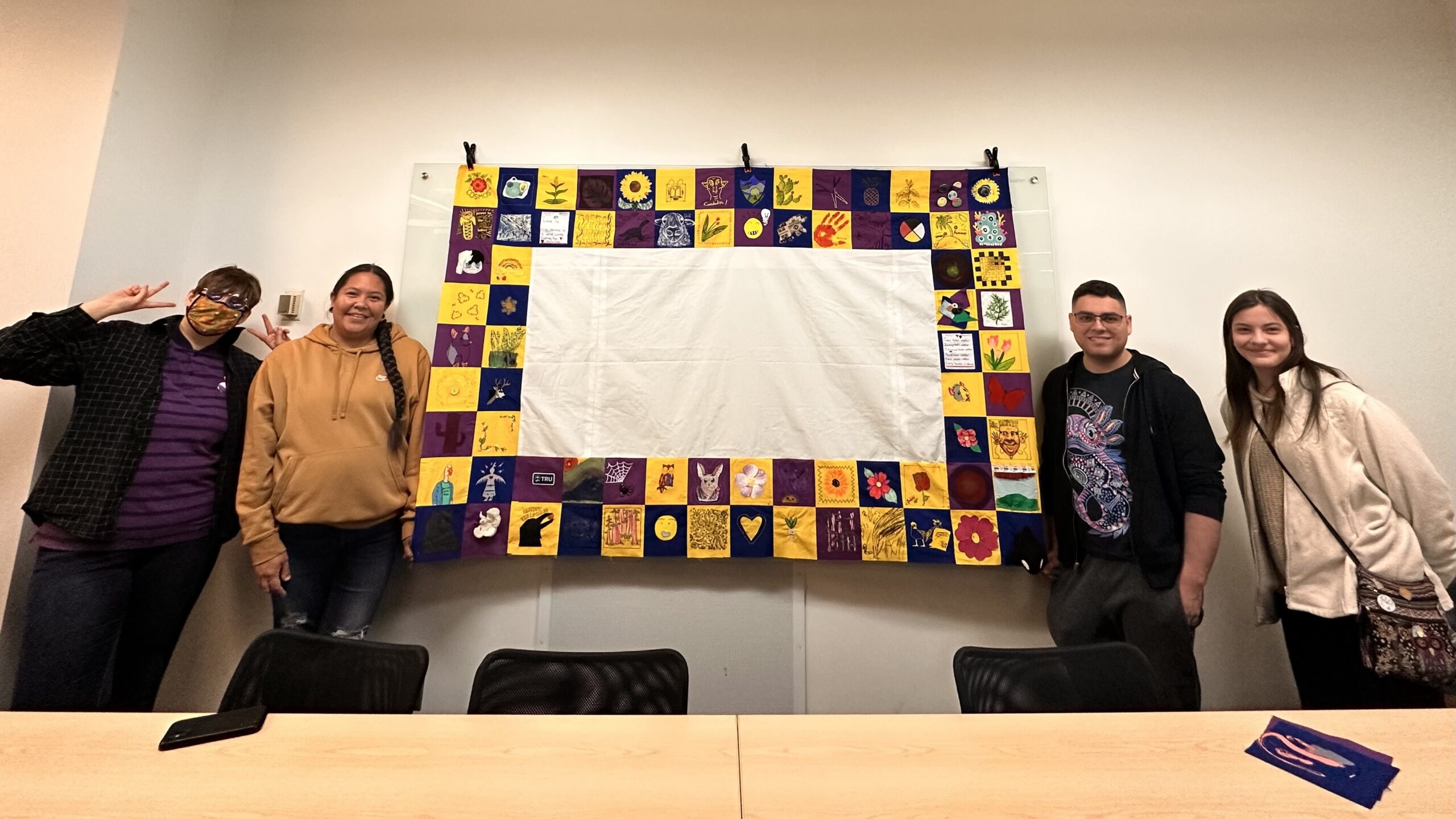
Bryanna Dyer, Chantel Manuel, Fausto Richard-Guerrero and Kaitlyn Barlett
The students came up with the design, instructional materials, and a plan to make it all happen and then organized multiple drop-in events so that students, staff, and faculty could contribute. The result far exceeded my expectations and shows how talented our community is and the ways that making can be both a personal and collective experience that strengthens our connections to one another.
We are currently putting the finishing touches on the banner and it will be hanging in the Makerspace soon!
Repair Cafes

We once again hosted two Repair Cafés this year in partnership with the local non-profit Kamloops Repair Café, the TRU Sustainability Office, and Trades faculty member Ben Lovely. These events are open to all members of the community and are an opportunity to bring in small items such as household electronics and clothing to be repaired by volunteers. The fall event had over 60 attendees, which is low in our experience, and we suspect was due to being scheduled at a bad time for students to attend and not being marketed enough. The three groups worked together to improve scheduling and promotion, and our spring event was our busiest yet, with over 110 attendees.
These events advance our value of community by bringing together the TRU and greater Kamloops community and provide remarkable opportunities for intergenerational and intercultural learning. These events also support sustainability by promoting repair over disposability and teaching practical repair skills to participants.
Environmental Science Students 3D Scan and Print Skulls!
Shannon Werden, a Master of Science in Environmental Science student working in Dr. Karl Larsen’s lab created a 3D scan and print of a stwelelél̓qw, or fisher (Pekania pennanti) skull for her research on these animals in the Cariboo region. After discovering no existing digital models were available, she learned to use our 3D scanning and printing tools to create a high-quality model based on one of her research specimens. She then used that as part of her poster presentation.


I love this project because it exemplifies so many aspects of how I want the space to work: Shannon identified a genuine need related to her interests, learned multiple new skills, and created something new with real academic and personal value. By planning to share her model online, she’s also extending the impact of her work to benefit the broader community.
If curious, we have one of the fisher skull prints in the Makerspace in the 3D print room.
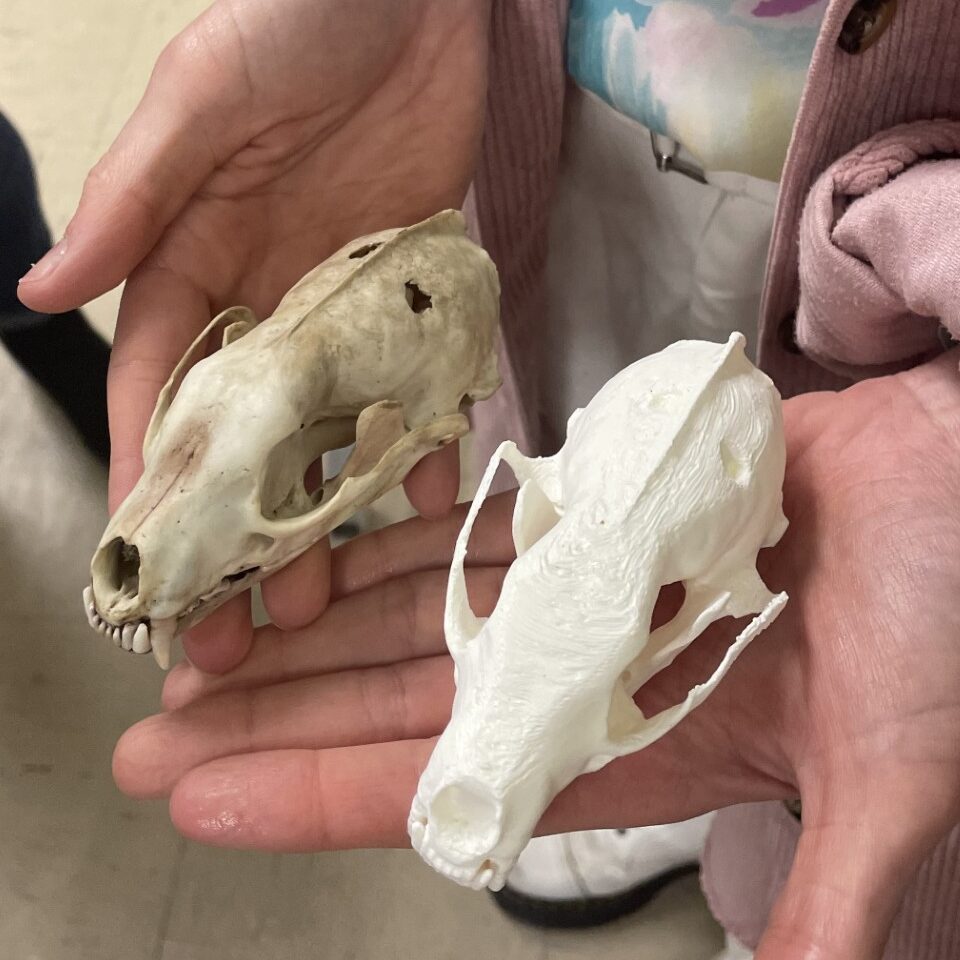
Engineering Vending Machine

In this project Engineering students Wilson Wedel, Norah Macaulay, and Fraser Schilling designed and built a fully functional vending machine using many of the resources available from the Makerspace. To quote the students “The project incorporates 11 different Arduino components, more than 450 lines of code, 9 unique systems, and over 30 3D-printed parts. Without Makerspace this project would not be possible, a huge shout out to that amazing workspace. I encourage engineering students to check it out and utilize it for all your wild projects!”
I love this project because it’s honestly just impressive and it shows the amount of talent and knowledge our students have and what can happen when you give them access to resources and a culture that encourages them to push the boundaries of what is possible.
There is a video of the vending machine on our Instagram for those who want to see it in action!
Making a Staff Quilt

One of the nicest things about working in the Makerspace is getting to know other staff and learning about their interests and experiences. In the fall, Library staff collaborated to create a small staff quilt that now hangs in our textile room. This project wouldn’t have been possible without TRU Library technicians Leah and Kathleen, who helped organize the event and taught us all how to make our squares. We’ve had a fair number of events run by and for CUPE staff over the last few years, including book repair and zine-making, and it’s something I hope we do more in the future.
Our Biggest Women in Engineering Collaboration Yet!
This spring we hosted over 45 high school girls as part of the largest Women in Engineering event to date. This initiative, now in its third year, divides participants into two groups who alternate between engineering robotics sessions with Engineering faculty and hands-on exploration in the Makerspace.
What made this year particularly special was how the students embraced our makerspace philosophy of self-directed learning. Given the large group size, we emphasized from the start that they would need to collaborate and help each other – just as our regular users do. The students absolutely met this challenge, diving into various projects and supporting one another’s learning. By the end of each session the space was a mess, and they had made an impressive number of iron-on vinyl T-shirts, 3D prints, stickers, buttons, and even short podcasts.
Special thanks to our Makerspace Student Ambassadors Wendy and Damien, who volunteered their Saturday to help make this event such a success!
Art Therapy Workshops with People & Culture
This year we worked with People and Culture (formerly HR) to host three 4-week art therapy courses for CUPE staff, led by therapist Pamela Fry. While our role was primarily providing space and resources, this is a nice example of how we can partner with campus groups to help serve our community. Events like this are also important because they bring in CUPE staff who might not know about the Makerspace or realize that it was designed as much for them as for students and faculty.
This year, I’ve noticed more CUPE staff regularly using the Makerspace. Some visit during breaks for personal projects, while others incorporate the space into their work. This organic growth in staff participation is particularly meaningful, as it helps create an environment where staff, faculty, and students can work alongside each other as peers, breaking down traditional campus hierarchies and fostering a more inclusive community.
3D Printing Snail Settings Wall

to the door to the 3D print room
Finally, this fall we finished making our “Snail Settings Wall”, which is designed to help users understand how the different 3D printer settings impact the resulting print. Staff made original artwork for the vinyl cutouts of local flowers. The snail was designed by previous Makerspace Student Ambassador and Bachelor of Fine Arts graduate Adrian Romeo.
I think this project sits in a sweet spot for us: it expands access by making complicated things simpler; it encourages students to experiment and try new things; it supports self-directed learning; and it’s designed around local flora and fauna. It’s also cute!
See more about the Snail Setting Wall on our blog: Introducing the 3D Printer Snail Settings Wall – TRU Library Makerspace (C7elelkstén’)
Statistics
Trends Over Three Years
Let’s start by looking at the last three years because I think the data shows several things that I think are interesting. Note that we soft opened in January 2022 and fully opened in March 2022, so this data misses the first few months after we opened but gives full annual data for our first three years for the May – April periods.
First, the number of people using the Makerspace has grown over time, as shown by door counts, website visits, events, room booking, and item circulation. This last year from May 2024 to the end of April 2025, was our busiest yet. We had over 19,000 visitors in that time, and March 2025 was our busiest month ever, with 2831 people entering the space. This is technically an undercount, as we have one door that does not have a door counter and so anyone using it isn’t being counted.

While visitor count has gone up, what has gone down is reference interactions. Each reference interaction represents a time when a staff member helped someone, not the number of questions they answered. For example, if a user asks 10 questions in a single interaction, we count that as 1 interaction. While I haven’t collected any specific data about this, I have a couple of ideas about why reference interactions might be down even when use is at an all-time high:
- We’ve gotten better at setting people up for success, and so they need less help from us. When we opened, we didn’t know how to help people in the space, so we often had to help them multiple times. We know so much more now about how the technologies work and what common problems arise, so we are heading them off earlier and answering less subsequent questions.
- We’ve created a lot of instructional scaffolding such as tutorials and FAQs that help users get started and troubleshoot on their own.
- We’ve gotten better at encouraging students to go further when learning-by-doing and being self-directed in their learning. When we first opened, we didn’t really know how to make this happen, and it seemed a little vague and maybe a little scary. Sometimes it felt like providing bad service. Over the last three years we’ve done a lot to build our own confidence and figure out how best to help students help themselves.

Monthly Circulations, and Room Reservations
We’re also seeing a slow but steady increase in the number of events and event attendees, room reservations, and item circulation. I think of these as force multipliers for our impact. Events often represent situations where we can have a large impact through collaboration, for example through repair cafés or curricular integrations with classes. Room reservations and item circulations (such as the audio recorder, cameras, sewing machine, and other tools we let people check out) are ways we have an impact outside the space.

One of our other divergent statistics is 3D printing, which has gone down over 3 years. This may be partly due to how we were capturing statistics when we started in January 2022, and since then we have found a more consistent way of capturing more accurate statistics.
But I do think there is something happening here. Specifically, in 2024 we implemented new 3D printing guidelines (link: https://makerspace.trubox.ca/2023/11/24/new-3d-printing-rules-and-guidelines/) that were meant to encourage sustainability and experimentation while reducing the number of failed and low-quality prints. I think part of what we’re seeing here is the impact of those guidelines.
I also think we are getting better at maintaining and running the 3D printers. Our staff in particular now have 3 years of experience running 3D printers in a busy, constantly changing environment filled with novices just learning how to print.
And while I don’t have data to support this yet, I think the quality and complexity of what our students are printing is increasing. We are seeing more interesting and complex prints being done more successfully and with less print failures or support required by our staff.
2024-2025 Statistics
October and March continue to be our busiest months of the year. This is true for our gate count (the number of people coming into our space) as well as the number of visitors to our website and the number of questions that we answer.

This can be seen most clearly in the number of times we helped users.

Questions about Technology in 2024-2025

We also record what technology we are helping someone with, though the following chart has an unusual number of “null” values due to an error in how data was entered that happened in May, 2024.
As in previous years, 3D printing is the technology we help users with most frequently. This is partly because 3D printing is the only technology where we require people talk to a staff member to use and partly, I think, because 3D printing has more technical steps that users often don’t feel confident doing on their own. In the future, we want to find more ways to encourage users to take more of these steps on their own, knowing that we will help troubleshoot any issues that do arise.
Textiles and embroidery combined are the second most frequently asked about categories, which reflects the popularity of the Textile Lab. Even though many of the users of that room are relatively experienced and self-sufficient, it is interesting to note that many users still seek help from staff.
The recording studio is also very popular but generates less questions, as many users are self-sufficient, and recording is complex once you get beyond the basics.
Finally, we have some categories which could probably be removed in the future, like computer prototyping and robotics. These were added when we opened the Makerspace, but we only really support them by lending materials, and we’ve never had much uptake. When you create something totally new, not everything is going to work out. And it’s likely that we slowly stop providing these tools over time and focus on the things that have the most need.
Workshops, Events, and Outreach
Workshops
This year we tried a couple of new workshops, including ones on AI, multimodal teaching, and Procreate.
I taught several workshops on generative AI for staff and faculty with the framing of using our professional expertise as a framework for evaluating its potential and limitations. These went really well, but demonstrated how varied the needs among faculty and staff are and how difficult it is going to be to use a set workshop of curriculum.
I also collaborated with CELT Faculty Member Alexis Brown on two Multimodal Teaching workshops. While attendance was modest (about 10 faculty total), the impact has been significant – we’ve already seen three course integrations implemented, with more planned for next year.
Finally, Communications and Visual Arts faculty member Clement Yeh led a popular digital illustration workshop on Procreate, setting a model for future skill-specific workshops led by faculty experts. I hope to offer more specialized workshops taught by faculty and staff who can share their expertise with our community in the future.
| Date | Event | Attendees |
| 2024-09-04 | Make Your First 3D Print: A Hands-On Beginner’s Workshop | 3 |
| 2024-09-09 | Co-working with AI for LTI | 10 |
| 2024-10-09 | AI Workshop with LTI | 14 |
| 2024-11-04 | Make Your First 3D Print: A Hands-On Beginner’s Workshop | 4 |
| 2024-11-20 | Multimodality in the Makerspace | 11 |
| 2024-11-20 | Workshop: Make Your First 3D Print: A Hands-On Beginner’s Workshop | 2 |
| 2024-11-25 | Universal Design for Learning Communuty of Practice GenAI workshop | 7 |
| 2025-02-06 | Make Your First 3D Print: A Hands-On Beginner’s Workshop | 4 |
| 2025-02-26 | Integrating Multimodality in the Curriculum | 4 |
| 2025-02-28 | Make Your First 3D Print: A Hands-On Beginner’s Workshop | 4 |
Community Events and Outreach
We hosted 17 events this year, with over 375 attendees. Most of these events are organized with campus partners. For example, the Repair Cafés are organized with Sustainability and Kamloops Repair Café, Moccasin making is organized with Indigenous Education, and the Women in STEM event is organized with Engineering. Aside from these I also hosted a number of outreach events with campus groups and departments, which this year included groups like Integrated Planning and Research Rookies.
Not included here are the 12 art therapy classes hosted by People and Culture that are discussed in the highlight section.
| Date | Event | Attendees |
| 2024-10-10 | Moccasin Making with Indigenous Education | 10 |
| 2024-10-16 | Moccasin Making with Indigenous Education | 12 |
| 2024-10-17 | Procreate Digital Illustration Workshop | 17 |
| 2024-10-23 | Moccasin Making with Indigenous Education | 12 |
| 2024-10-30 | Moccasin Making with Indigenous Education | 10 |
| 2024-11-18 | BYOC: Art upcycle event | 8 |
| 2024-11-20 | BYOC: Art upcycle event | 1 |
| 2024-11-21 | Repair Cafe | 60 |
| 2024-12-02 | Introduction to the TRU Library Makerspace for SD73 teacher librarians | 15 |
| 2024-12-09 | Wellness Centre Crafting Event | 10 |
| 2025-01-10 | With integrated planning effectiveness. | 10 |
| 2025-02-08 | Research Rookies Tour and Talk | 20 |
| 2025-03-01 | Women in STEM Engineering and Robots | 45 |
| 2025-03-12 | Repair Cafe | 110 |
| 2025-03-03 | Art with Community Quilt Decorating Party | 5 |
| 2025-03-13 | Art with Community Quilt Decorating Party | 20 |
| 2025-03-14 | Art with Community Quilt Decorating Party | 10 |
Curriculum Integration

I hosted 23 classes this year from a diverse range of disciplines, including Engineering, Education, Business, Communications, Visual Arts, Adventure Studies, Arts Cohort, and the Masters of Social Justice.
Most class visits are meant to introduce students to the Makerspace, though many faculty now include either a brief required reflection assessment (Masters of Education, Business) or the optional use of the space for assignments (such as first-year engineering students building Rube Goldberg machines). A few have assignments that require the use of the space such as how 3D Foundation students scan and print their heads to use as models for sculpture. For some of these we do tutorials or have class time booked, so students have more access to tools.
I would very much like to continue encouraging more innovation in curriculum, including multimodal assignments, design projects, and digital humanities projects. The workshops with Alexis Brown on multimodal teaching have been a positive step in that direction, and I’m looking forward to us doing more in the future.
If any faculty are interested in this, I know both Alexis and I would be happy to chat more about this, regardless of if it would involve the makerspace.
| Date | Event | Attendees |
| 2024-09-20 | First year engineering | 20 |
| 2024-09-20 | First Year Engineering | 25 |
| 2024-09-27 | Tour for MEd students with Frederic Fovet | 25 |
| 2024-10-03 | Graduate Class with Cheryl Gladu | 40 |
| 2024-10-09 | 3D Foundations | 22 |
| 2024-10-16 | EDUC 5030 | 25 |
| 2024-10-22 | Creativity Class with Cheryl Gladu | 31 |
| 2024-10-22 | Creativity Class with Cheryl Gladu | 15 |
| 2024-10-30 | Graduate Class with Cheryl Gladu | 20 |
| 2024-10-30 | CLASS TOUR and Scanning Tutorial: 3D Foundations | 15 |
| 2024-11-13 | CLASS TOUR and Scanning Tutorial: 3D Foundations | 20 |
| 2024-11-18 | Adventure Studies | 25 |
| 2024-11-26 | STSS1010 Arts Cohort 1 tour with Jenna Goddard | 16 |
| 2025-01-09 | Orientation: Making Art with Community | 20 |
| 2025-02-04 | Sculpture 1/2 Intro to MakerSpace/3D Scanning | 8 |
| 2025-02-04 | Intro to Makerspace for MBA Students (2 groups – 30 minutes each) | 24 |
| 2025-02-06 | Class tour for MBA Students (1 group) | 14 |
| 2025-02-25 | Sculture 1/2 Scans to VR Session | 12 |
| 2025-03-04 | Sculpture scanning and 3D printing session | 8 |
| 2025-03-05 | 3D scanning tutorial | 12 |
| 2025-03-11 | Class tour: HRSJ 5120 – Settler Colonialism Decolonization and Responsibility | 30 |
| 2025-03-11 | Sculpture 1/2 VR Tour of Sculptures | 10 |
| 2025-03-18 | Makerspace Tour for EDUC 5030 Curriculum, Teaching and Learning | 20 |
Team Updates
Staff
Our staff continue to be the heart of the Makerspace. Staff create the welcoming environment that I believe is key to being a successful learning environment, and they do so with kindness, flexibility and expertise. From the beginning, staff have been fully involved in building how the makerspace operates and coming up with the steps and processes for running what is a very complicated learning environment, and this continues to be the case.
This year we saw three new staff members join Olivia and Dayun as part of our Operations Team in the fall: Jesse, Gwyneth, and Raychel. Raychel and Gwyneth have moved on to other roles in the library for now, and I am grateful for all their help this year. Olivia, Dayun, and Jesse are working in the Makerspace all summer.
Student Makerspace Ambassadors
This year we had five Makerspace Ambassadors: three returning (Geordie, Ali, and Deeparsh) and two new (Wendy and Damien). The Ambassadors played a vital role in giving tours, helping students with technologies, and running outreach events. This year they also took the initiative to run five successful tabling events in House of Learning and Old Main to increase outreach.
Next year will bring significant changes to our ambassador team. Wendy is graduating, and Damien is heading to Germany for a co-op placement. Additionally, Geordie, Lee, and Deeparsh will be moving on as part of our new three-term limit policy, which aims to give more students the opportunity to be Makerspace Ambassadors. Both Geordie and Deeparsh have been with us since we opened, while Lee joined us a year and a half ago. While I’ll miss their enthusiasm and dedication to making the Makerspace the best it can be, I’m excited to see where their futures take them.
Looking Forward
In July I start a six-month sabbatical looking at how makerspaces can integrate critical and ecological contexts about technologies while remaining true to their student-driven pedagogies and values. When I get back in January, I’m hoping to start integrating what I learned from my sabbatical into the Makerspace by encouraging users to think critically about their use of technologies and the impacts on themselves and their communities. I really love the exploratory and student-driven nature of makerspaces, and I don’t want to turn them into didactic spaces, but I also think that it’s important to think about their impacts.
While I am gone my colleague Erin May will be overseeing the Makerspace. Erin helped me start a pilot Makerspace in 2019 and has been the Librarian for Education and Social Work, as well as overseeing scholarly communication. I know Erin is going to do an excellent job working with our staff and users over the next six months and I’m excited to see what happens while I am away.
See you all in 2026!
